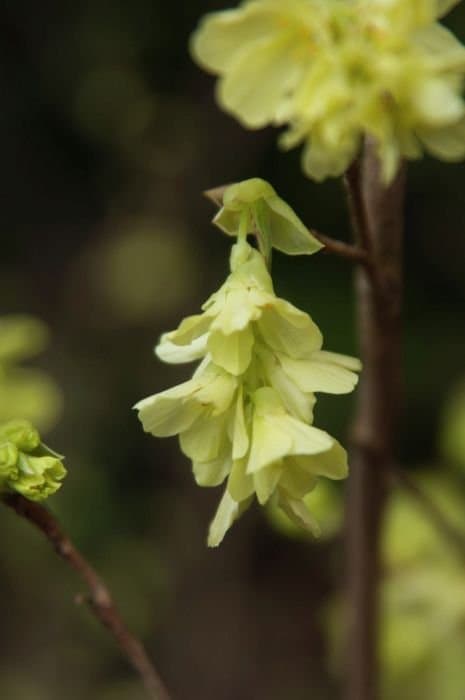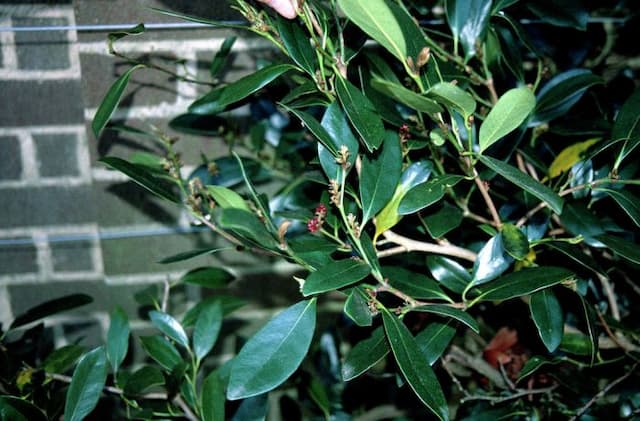Witch Hazel Hamamelis × intermedia 'Vesna'

ABOUT
The plant with the common name Witch Hazel 'Vesna' is a captivating deciduous shrub that draws attention with its unique and striking flowers. The flowers bloom in the late winter to early spring, producing a delightful display when much of the landscape is still dormant. Each bloom features narrow, ribbon-like petals that exude an enchanting fragrance. The petals display a warm, sunny yellow to orange hue, providing a cheerful contrast against the bare branches. The Witch Hazel 'Vesna' also boasts attractive foliage, with leaves that emerge in a fresh green color and gradually transition into appealing shades of yellow, orange, and red in the autumn season. These flamboyant autumnal colors make the Witch Hazel 'Vesna' a plant of interest even after the blooming period has ended, adding to the aesthetic value of any garden during multiple seasons. The overall appearance of the plant is one of rustic charm and delicate beauty, making it a beloved choice for gardeners looking to create a focal point in their landscapes with a plant that offers both fragrant blooms and stunning fall foliage.
About this plant
 Names
NamesFamily
Hamamelidaceae
Synonyms
Witch Hazel, Hybrid Witch Hazel, Vesna Witch Hazel
Common names
Hamamelis × intermedia 'Vesna'.
 Toxicity
ToxicityTo humans
Witch Hazel 'Vesna' is not commonly known to be toxic to humans. Typically, witch hazel is considered safe and is even used in many over-the-counter skin care products for its astringent properties. However, as with any plant, individual allergies could potentially occur. If ingested in large quantities, it may cause stomach upset. Still, there are no well-documented cases of poisoning from ingesting witch hazel.
To pets
Witch Hazel 'Vesna' is generally not considered toxic to pets. There is little to no information suggesting that witch hazel is harmful to dogs, cats, or other household animals. However, the ingestion of any plant material could potentially lead to mild digestive upset in some pets. If a pet ingests a large amount of the plant and shows signs of illness, it is advisable to contact a veterinarian.
 Characteristics
CharacteristicsLife cycle
Perennials
Foliage type
Deciduous
Color of leaves
Green
Flower color
Yellow
Height
12 feet (3.65 meters)
Spread
12 feet (3.65 meters)
Plant type
Shrub
Hardiness zones
5
Native area
Asia
Benefits
 General Benefits
General Benefits- Winter Interest: Hamamelis, commonly known as "witch hazel," blooms in late winter to early spring, providing color when most plants are dormant.
- Fragrant Flowers: The 'Vesna' cultivar produces fragrant flowers that can add a pleasant aroma to the garden.
- Landscape Versatility: Witch hazel can be used for a variety of landscape applications, including specimen planting, shrub borders, and woodland gardens.
- Attracts Wildlife: The flowers can attract pollinators like bees and sometimes serve as an early nectar source.
- Autumn Foliage: In the fall, witch hazel offers vibrant fall foliage, typically in shades of yellow to red, adding autumn interest to the landscape.
- Low Maintenance: Witch hazel generally requires minimal care once established, making it suitable for gardeners of all skill levels.
- Tolerance to Varied Conditions: The plant is tolerant of a range of soil conditions, including clay soil, and can handle some environmental stress.
- Erosion Control: The shrub can be used on slopes or areas prone to erosion to help stabilize soil.
 Medical Properties
Medical PropertiesThis plant is not used for medical purposes.
 Air-purifying Qualities
Air-purifying QualitiesThis plant is not specifically known for air purifying qualities.
 Other Uses
Other Uses- Photography: The bright yellow flowers of Witch Hazel can be used as a stunning backdrop or focus for spring photography, enhancing garden and nature photos.
- Dyeing fabric: The bark and leaves, rich in tannins, can be used to create natural dyes for textiles, yielding colors ranging from yellow to orange.
- Artistic inspiration: Artists may draw inspiration from Witch Hazel's unique form and vibrant flowers for paintings, drawings, and sculptures.
- Erosion control: Planting Witch Hazel on slopes can help stabilize soil and control erosion due to its hardy root system.
- Privacy screening: Its dense, spreading nature makes Witch Hazel an ideal plant for creating privacy screens in a garden setting.
- Educational purposes: Witch Hazel can be used in schools or educational programs to teach students about plant biology and hybridization.
- Gardening for wildlife: The shrub provides habitat and food sources for pollinators like bees and butterflies as well as birds that feed on its seeds.
- Winter interest: Witch Hazel can bring color and life to a winter garden when most plants are dormant, thanks to its late-winter blossoms.
- Floral arrangements: Fresh or dried Witch Hazel flowers can add an unusual and fragrant element to bouquets and indoor arrangements.
- Culinary curiosity: While not commonly used for cooking, Witch Hazel petals could be used as an edible decoration for specialty desserts, after ensuring they are free from pesticides and safe for consumption.
Interesting Facts
 Feng Shui
Feng ShuiThe Witch Hazel is not used in Feng Shui practice.
 Zodiac Sign Compitability
Zodiac Sign CompitabilityThe Witch Hazel is not used in astrology practice.
 Plant Symbolism
Plant Symbolism- Resilience: Witch Hazel, the common name for Hamamelis × intermedia 'Vesna', often blooms in late winter, withstanding the chill of the last frosts - symbolizing the ability to endure and triumph over harsh conditions.
- Protection: Historically, Witch Hazel was believed to ward off negative influences and protect against evil spirits, due to its astringent properties and use in traditional medicine.
- Healing: With its therapeutic uses in skin care and inflammation reduction, Witch Hazel signifies healing, both physical and emotional.
- Adaptability: As a plant that bridges the winter and spring seasons, it embodies adaptability, thriving in the transitional periods of life.
- Uniqueness: The unusual, spider-like flowers of Witch Hazel bloom when most other plants lie dormant, highlighting uniqueness and the beauty of standing out.
 Water
WaterWitch Hazel should be watered deeply, ensuring that the water reaches the roots, about once a week during the growing season, and less frequently during the dormant season. During hot and dry periods, increase the frequency to twice a week. The soil should not be allowed to dry out completely but should not be waterlogged either. A good rule of thumb is to provide the plant with about 1 to 1.5 gallons of water every week, adjusting based on rainfall and temperature conditions.
 Light
LightWitch Hazel thrives in full sun to partial shade but prefers several hours of morning sunlight with some afternoon shade. The best spot is one where the plant is sheltered from the harsh afternoon sun, especially in hotter climates. Adequate light will ensure the most vibrant flower production in late winter to early spring.
 Temperature
TemperatureWitch Hazel is hardy and can tolerate a range of temperatures, from approximately -20 to 90 degrees Fahrenheit. However, the ideal temperature range for the plant is between 30 to 75 degrees Fahrenheit. Avoid dramatically fluctuating temperatures and protect the plant from severe winter winds to prevent damage to the branches.
 Pruning
PruningWitch Hazel benefits from pruning to maintain shape and encourage healthy growth, although heavy pruning is rarely needed. Prune in late winter or early spring, after the plant has flowered, to remove any dead or crossing branches and to shape the plant. Perform touch-up pruning as needed, but avoid cutting into old wood, as this can reduce flowering.
 Cleaning
CleaningAs needed
 Soil
SoilWitch Hazel 'Vesna' thrives in well-draining, loamy soil with a slight acidity to neutral pH range, generally between 5.5 and 7. A mix of two parts garden soil, one part peat moss, and one part sand or perlite is ideal to ensure proper drainage and aeration while retaining sufficient moisture.
 Repotting
RepottingWitch Hazel 'Vesna' does not require frequent repotting; it can be repotted every 3 to 5 years or when it becomes root-bound. Choose a pot slightly larger than the current one to allow for growth.
 Humidity & Misting
Humidity & MistingWitch Hazel 'Vesna' prefers moderate humidity levels, generally around 40-60%. It is adaptable to average home humidity but benefits from increased humidity in very dry indoor environments.
 Suitable locations
Suitable locationsIndoor
Place Witch Hazel 'Vesna' near a sunny window.
Outdoor
Plant Witch Hazel 'Vesna' in partial shade to full sun.
Hardiness zone
5-8 USDA
 Life cycle
Life cycleThe Witch Hazel 'Vesna', a hybrid variety, starts its life cycle as a dormant seed, which upon experiencing the right conditions of cold stratification followed by warmth, germinates in the early spring. The seedling then begins to establish its root system while sending forth shoots that will develop into stems and leaves. Throughout the spring and summer, the plant enters a period of vegetative growth, producing larger and more extensive foliage and branching, thus increasing its photosynthetic capacity for energy production. As the plant matures and enters the flowering stage, usually during the late winter to early spring, the Witch Hazel 'Vesna' produces fragrant yellow to orange flowers with distinctive ribbon-like petals. After pollination, typically by wind or insects, the flowers develop into seed capsules that mature in the fall and eventually eject seeds to start a new generation. The Witch Hazel 'Vesna' also enters a period of dormancy in the winter, reducing metabolic activity in preparation for colder temperatures.
 Propogation
PropogationPropogation time
Late winter
The most popular method of propagation for the Witch Hazel (Hamamelis × intermedia 'Vesna') is through softwood cuttings. This is typically done in late spring to early summer, when new growth is still pliable and has not yet hardened into woody stems. Cuttings should be about 4 to 6 inches (10 to 15 centimeters) long and taken from the current season's growth. Each cutting should have a few leaves at the top and be trimmed just below a node, the point from where leaves or branches grow. The bottom cut end should be dipped into rooting hormone powder to encourage root development and then inserted into a pot filled with a moistened mixture of perlite and peat. The pot must be kept under high humidity conditions, such as inside a plastic bag or under a dome, and in indirect light until the cuttings have rooted, which may take several weeks.









